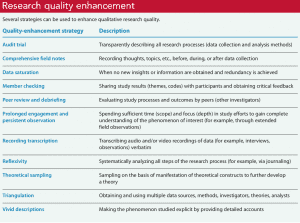This type of research can reveal important information that quantitative research can’t.
Takeaways:
- Qualitative research is valuable because it approaches a phenomenon, such as a clinical problem, about which little is known by trying to understand its many facets.
- Most qualitative research is emergent, holistic, detailed, and uses many strategies to collect data.
- Qualitative research generates evidence and helps nurses determine patient preferences.
Research 101: Descriptive statistics
Differentiating research, evidence-based practice, and quality improvement
How to appraise quantitative research articles
All nurses are expected to understand and apply evidence to their professional practice. Some of the evidence should be in the form of research, which fills gaps in knowledge, developing and expanding on current understanding. Both quantitative and qualitative research methods inform nursing practice, but quantitative research tends to be more emphasized. In addition, many nurses don’t feel comfortable conducting or evaluating qualitative research. But once you understand qualitative research, you can more easily apply it to your nursing practice.
What is qualitative research?
Defining qualitative research can be challenging. In fact, some authors suggest that providing a simple definition is contrary to the method’s philosophy. Qualitative research approaches a phenomenon, such as a clinical problem, from a place of unknowing and attempts to understand its many facets. This makes qualitative research particularly useful when little is known about a phenomenon because the research helps identify key concepts and constructs. Qualitative research sets the foundation for future quantitative or qualitative research. Qualitative research also can stand alone without quantitative research.
Although qualitative research is diverse, certain characteristics—holism, subjectivity, intersubjectivity, and situated contexts—guide its methodology. This type of research stresses the importance of studying each individual as a holistic system (holism) influenced by surroundings (situated contexts); each person develops his or her own subjective world (subjectivity) that’s influenced by interactions with others (intersubjectivity) and surroundings (situated contexts). Think of it this way: Each person experiences and interprets the world differently based on many factors, including his or her history and interactions. The truth is a composite of realities.
 Qualitative research designs
Qualitative research designs
Because qualitative research explores diverse topics and examines phenomena where little is known, designs and methodologies vary. Despite this variation, most qualitative research designs are emergent and holistic. In addition, they require merging data collection strategies and an intensely involved researcher. (See Research design characteristics.)
Although qualitative research designs are emergent, advanced planning and careful consideration should include identifying a phenomenon of interest, selecting a research design, indicating broad data collection strategies and opportunities to enhance study quality, and considering and/or setting aside (bracketing) personal biases, views, and assumptions.
Many qualitative research designs are used in nursing. Most originated in other disciplines, while some claim no link to a particular disciplinary tradition. Designs that aren’t linked to a discipline, such as descriptive designs, may borrow techniques from other methodologies; some authors don’t consider them to be rigorous (high-quality and trustworthy). (See Common qualitative research designs.)
Sampling approaches
Sampling approaches depend on the qualitative research design selected. However, in general, qualitative samples are small, nonrandom, emergently selected, and intensely studied. Qualitative research sampling is concerned with accurately representing and discovering meaning in experience, rather than generalizability. For this reason, researchers tend to look for participants or informants who are considered “information rich” because they maximize understanding by representing varying demographics and/or ranges of experiences. As a study progresses, researchers look for participants who confirm, challenge, modify, or enrich understanding of the phenomenon of interest. Many authors argue that the concepts and constructs discovered in qualitative research transcend a particular study, however, and find applicability to others. For example, consider a qualitative study about the lived experience of minority nursing faculty and the incivility they endure. The concepts learned in this study may transcend nursing or minority faculty members and also apply to other populations, such as foreign-born students, nurses, or faculty.
Qualitative nursing research can take many forms. The design you choose will depend on the question you’re trying to answer.
| Design | Originating discipline | Description | Sample nursing research question |
| Action research | Education | Conducted by and for those taking action to improve or refine actions | What happens to the quality of nursing practice when we implement a peer-mentoring system? |
| Case study | Many | In-depth analysis of an entity or group of entities (case) | How is patient autonomy promoted by a unit? |
| Descriptive | N/A | Content analysis of data | What is the nursing role in end-of-life decisions? |
| Discourse analysis | Many | In-depth analysis of written, vocal, or sign language | What discourses are used in nursing practice and how do they shape practice? |
| Ethnography | Anthropology | In-depth analysis of a culture | How does Filipino culture influence childbirth experiences? |
| Ethology | Psychology | Biology of human behavior and events | What are the immediate underlying psychological and environmental causes of incivility in nursing? |
| Grounded theory | Sociology | Social processes within a social setting | How does the basic social process of role transition happen within the context of advanced practice nursing transitions? |
| Historical research | History | Past behaviors, events, conditions | When did nurses become researchers? |
| Narrative inquiry | Many | Story as the object of inquiry | How does one live with a diagnosis of scleroderma? |
| Phenomenology | Philosophy Psychology |
Lived experiences | What is the lived experience of nurses who were admitted as patients on their home practice unit? |
A sample size is estimated before a qualitative study begins, but the final sample size depends on the study scope, data quality, sensitivity of the research topic or phenomenon of interest, and researchers’ skills. For example, a study with a narrow scope, skilled researchers, and a nonsensitive topic likely will require a smaller sample. Data saturation frequently is a key consideration in final sample size. When no new insights or information are obtained, data saturation is attained and sampling stops, although researchers may analyze one or two more cases to be certain. (See Sampling types.)
Some controversy exists around the concept of saturation in qualitative nursing research. Thorne argues that saturation is a concept appropriate for grounded theory studies and not other study types. She suggests that “information power” is perhaps more appropriate terminology for qualitative nursing research sampling and sample size.
Data collection and analysis
Researchers are guided by their study design when choosing data collection and analysis methods. Common types of data collection include interviews (unstructured, semistructured, focus groups); observations of people, environments, or contexts; documents; records; artifacts; photographs; or journals. When collecting data, researchers must be mindful of gaining participant trust while also guarding against too much emotional involvement, ensuring comprehensive data collection and analysis, conducting appropriate data management, and engaging in reflexivity.
Reflexivity involves systematically analyzing each step of the research process. Unlike  quantitative researchers, who use validated instruments, qualitative researchers themselves are the instruments. They must strive to attain and manage high-quality data. Journaling can help researchers identify and manage how their behaviors and thoughts influence their study findings. When researchers bracket their preconceived notions when collecting and analyzing data, they help increase study rigor.
quantitative researchers, who use validated instruments, qualitative researchers themselves are the instruments. They must strive to attain and manage high-quality data. Journaling can help researchers identify and manage how their behaviors and thoughts influence their study findings. When researchers bracket their preconceived notions when collecting and analyzing data, they help increase study rigor.
Data usually are recorded in detailed notes, memos, and audio or visual recordings, which frequently are transcribed verbatim and analyzed manually or using software programs, such as ATLAS.ti, HyperRESEARCH, MAXQDA, or NVivo. Analyzing qualitative data is complex work. Researchers act as reductionists, distilling enormous amounts of data into concise yet rich and valuable knowledge. They code or identify themes, translating abstract ideas into meaningful information. The good news is that qualitative research typically is easy to understand because it’s reported in stories told in everyday language.
Evaluating a qualitative study
Evaluating qualitative research studies can be challenging. Many terms—rigor, validity, integrity, and trustworthiness—can describe study quality, but in the end you want to know whether the study’s findings accurately and comprehensively represent the phenomenon of interest. Many researchers identify a quality framework when discussing quality-enhancement strategies. Example frameworks include:
- Trustworthiness criteria framework, which enhances credibility, dependability, confirmability, transferability, and authenticity
- Validity in qualitative research framework, which enhances credibility, authenticity, criticality, integrity, explicitness, vividness, creativity, thoroughness, congruence, and sensitivity.
With all frameworks, many strategies can be used to help meet identified criteria and enhance quality. (See Research quality enhancement). And considering the study as a whole is important to evaluating its quality and rigor. For example, when looking for evidence of rigor, look for a clear and concise report title that describes the research topic and design and an abstract that summarizes key points (background, purpose, methods, results, conclusions).
Application to nursing practice
Qualitative research not only generates evidence but also can help nurses determine patient preferences. Without qualitative research, we can’t truly understand others, including their interpretations, meanings, needs, and wants. Qualitative research isn’t generalizable in the traditional sense, but it helps nurses open their minds to others’ experiences. For example, nurses can protect patient autonomy by understanding them and not reducing them to universal protocols or plans. As Munhall states, “Each person we encounter help[s] us discover what is best for [him or her]. The other person, not us, is truly the expert knower of [him- or herself].” Qualitative nursing research helps us understand the complexity and many facets of a problem and gives us insights as we encourage others’ voices and searches for meaning.
When paired with clinical judgment and other evidence, qualitative research helps us implement evidence-based practice successfully. For example, a phenomenological inquiry into the lived experience of disaster workers might help expose strengths and weaknesses of individuals, populations, and systems, providing areas of focused intervention. Or a phenomenological study of the lived experience of critical-care patients might expose factors (such dark rooms or no visible clocks) that contribute to delirium.
Successful implementation
Qualitative nursing research guides understanding in practice and sets the foundation for future quantitative and qualitative research. Knowing how to conduct and evaluate qualitative research can help nurses implement evidence-based practice successfully.
When evaluating a qualitative study, you should consider it as a whole. The following questions to consider when examining study quality and evidence of rigor are adapted from the Standards for Reporting Qualitative Research.
| Questions to consider | Evidence of rigor |
| Title, abstract, introduction | |
| o What is the report title and composition of the abstract?
o What is the problem and/or phenomenon of interest and study significance? o What is the purpose of the study and/or research question? |
→ Clear and concise report title describes the research topic and design (e.g., grounded theory) or data collection methods (e.g., interviews)
→ Abstract summarizes key points including background, purpose, methods, results, and conclusions → Problem and/or phenomenon of interest and significance is identified and well described, with a thorough review of relevant theories and/or other research → Study purpose and/or research question is identified and appropriate to the problem and/or phenomenon of interest and significance |
| Design, data collection and analysis, trustworthiness | |
| o What design and/or research paradigm was used?
o Is there evidence of researcher reflexivity? o What is the setting and context for the study? o What is the sampling approach? How and why were data selected? Why was sampling stopped? o Was institutional review board (IRB) approval obtained and were other issues relating to protection of human subjects outlined? |
→ Design (e.g., phenomenology, ethnography), research paradigm (e.g., constructivist), and guiding theory or model, as appropriate, are identified, along with well-described rationales
→ Design is appropriate to research problem and/or phenomenon of interest → Researcher characteristics that may influence the study are identified and well described, as well as methods to protect against these influences (e.g., journaling, bracketing) → Settings, sites, and contexts are identified and well described, along with well-described rationales |
| o What data collection and analysis instruments and/or technologies were used?
o What is the method for data processing and analysis? o What is the composition of the data? o What strategies were used to enhance quality and trustworthiness? |
→ Sampling approach and how and why data were selected are identified and well described, along with well-described rationales; participant inclusion and exclusion criteria are outlined and appropriate
→ Criteria for deciding when sampling stops is outlined (e.g., saturation) and rationale is provided and appropriate → Documentation of IRB approval or explanation of lack thereof provided; consent, confidentiality, data security, and other protection of human subject issues are well described and thorough → Description of instruments (e.g., interview scripts, observation logs) and technologies (e.g., audio-recorders) used is provided, including how instruments were developed; description of if and how these changed during the study is given, along with well-described rationales → Types of data collected, details of data collection, analysis, and other processing procedures are well described and thorough, along with well-described rationales → Number and characteristics of participants and/or other data are described and appropriate → Strategies to enhance quality and trustworthiness (e.g., member checking) are identified, comprehensive, and appropriate, along with well-described rationales; trustworthiness framework, if identified, is established from experts (e.g., Lincoln and Guba, Whittemore et al.) and strategies are appropriate to this framework |
| Results or findings | |
| o Were main study results synthesized and interpreted? If applicable, were they developed into a theory or integrated with prior research?
o Were results linked to empirical data? |
→ Main results (e.g., themes) are presented and well described and a theory or model is developed and described, if applicable; results are integrated with prior research
→ Adequate evidence (e.g., direct quotes from interviews, field notes) is provided to support main study results |
| Discussion | |
| o Are study results described in relation to prior work?
o Are study implications, applicability, and contributions to nursing identified? o Are study limitations outlined? |
→ Concise summary of main results are provided and thorough, including relation to prior works (e.g., connection, support, elaboration, challenging prior conclusions)
→ Thorough discussion of study implications, applicability, and unique contributions to nursing is provided → Study limitations are described thoroughly and future improvements and/or research topics are suggested |
| Conflicts of interest, funding, support | |
| o Are potential or perceived conflicts of interest identified and how were these managed?
o If applicable, what sources of funding or other support did the study receive? |
→ All potential or perceived conflicts of interest are identified and well described; methods to manage potential or perceived conflicts of interest are identified and appear to protect study integrity
→ All sources of funding and other support are identified and well described, along with the roles the funders and support played in study efforts; they do not appear to interfere with study integrity |
Jennifer Chicca is a PhD candidate at the Indiana University of Pennsylvania in Indiana, Pennsylvania, and a part-time faculty member at the University of North Carolina Wilmington.
References
Amankwaa L. Creating protocols for trustworthiness in qualitative research. J Cult Divers. 2016;23(3):121-7.
Cuthbert CA, Moules N. The application of qualitative research findings to oncology nursing practice. Oncol Nurs Forum. 2014;41(6):683-5.
Guba E, Lincoln Y. Competing paradigms in qualitative research. In: Denzin NK, Lincoln YS, eds. Handbook of Qualitative Research. Thousand Oaks, CA: SAGE Publications, Inc.;1994: 105-17.
Lincoln YS, Guba EG. Naturalistic Inquiry. Thousand Oaks, CA: SAGE Publications, Inc.; 1985.
Munhall PL. Nursing Research: A Qualitative Perspective. 5th ed. Sudbury, MA: Jones & Bartlett Learning; 2012.
Nicholls D. Qualitative research. Part 1: Philosophies. Int J Ther Rehabil. 2017;24(1):26-33.
Nicholls D. Qualitative research. Part 2: Methodology. Int J Ther Rehabil. 2017;24(2):71-7.
Nicholls D. Qualitative research. Part 3: Methods. Int J Ther Rehabil. 2017;24(3):114-21.
O’Brien BC, Harris IB, Beckman TJ, Reed DA, Cook DA. Standards for reporting qualitative research: A synthesis of recommendations. Acad Med. 2014;89(9):1245-51.
Polit DF, Beck CT. Nursing Research: Generating and Assessing Evidence for Nursing Practice. 10th ed. Philadelphia, PA: Wolters Kluwer; 2017.
Thorne S. Saturation in qualitative nursing studies: Untangling the misleading message around saturation in qualitative nursing studies. Nurse Auth Ed. 2020;30(1):5. naepub.com/reporting-research/2020-30-1-5
Whittemore R, Chase SK, Mandle CL. Validity in qualitative research. Qual Health Res. 2001;11(4):522-37.
Williams B. Understanding qualitative research. Am Nurse Today. 2015;10(7):40-2.



















